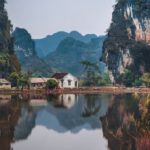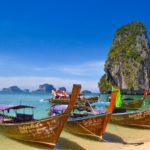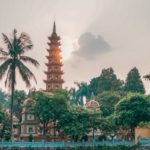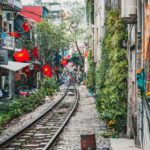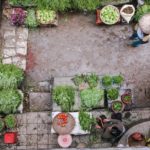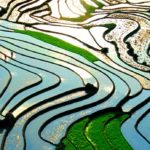Exploring the Remote Caves of Phong Nha, Quang Binh
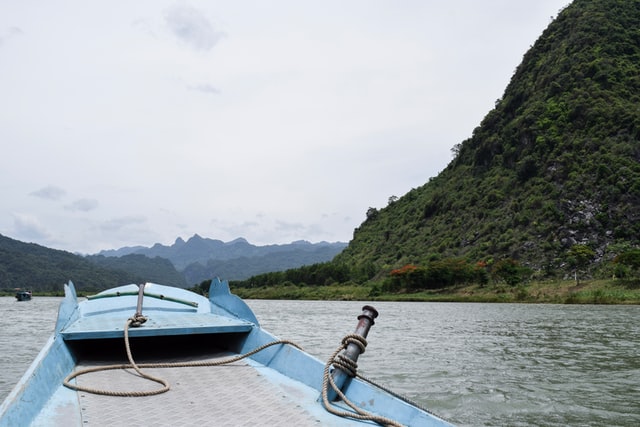
Vietnam is a country of contrast with rapid changes. From Ho Chi Minh, the massive, vibrant cosmopolitan city in the south, it is hard to imagine there are still small villages in the hills with no roads.
Phong Nha, Quang Binh province is in the central highlands of Vietnam, and it’s the narrowest point between the ocean and Laos. Reading that it was one of the most remote and unvisited national parks it seemed like the perfect choice for a much needed break from the city.
I found towering jagged hills reaching up to misty skies, split by rivers winding over billiard table green. Rice paddies spread over the valleys and impenetrable rich forest climbed high over the limestone. The pace of life turned down several notches. Bicycles replaced motorbikes and empty roads and dirt tracks hosted more buffalos and chickens than people.
Before my first visit to Phong Nha, I thought caves were dull, dark places joined by narrow cold passageways with no further attraction than the light at the end. How wrong I was.
Rainwater seeping through cracks and crevices has hollowed out the hills making it a cavers’ paradise. Before my first visit to Phong Nha, I thought caves were dull, dark places joined by narrow cold passageways with no further attraction than the light at the end. How wrong I was.
Phong Nha and Paradise Caves are easily accessible. Vast caverns with formations as huge as double decker buses. White calcite folds down as if it soft cake icing. Jagged teeth reach up from the floor and the walls are washed with a rainbow of colour. I was truly amazed by what could be found underground.
With my curiosity ignited, I wanted to go further, to see what else there was to find in these underground palaces. Tu Lan is for the more adventurous. A wet cave system where I spent two day swimming, climbing and squeezing through holes to access glittering calcite, sandy beaches and folds of rocks filled with giant cave pearls.
I was so enthralled by the area that when I discovered Phong Nha was also home to the largest cave in the world, Son Doong, I immediately signed up for a return visit and a five-day trek. I hiked through beautiful river valleys with clouds of vibrant butterflies, clear water and rich green foliage stretching to a summer blue sky. Afterwards, I hiked through the Hang En cave, home to a thousand swifts and a crystal blue lake. Then I experienced the ultimate two-day climb and scramble through Son Doong to the dolines, where the roof had collapsed and jungle had returned in a unique, pristine eco-system.
Exploring the Remote Caves of Phong Nha, Quang Binh.
The caves have been a lifeline for the communities in Phong Nah. In 1990 it lost 50% of its population to starvation and malaria. It took 4 hours to get from Dong Hoi, the closest substantial town on the coast. There were no tarmac roads and only one brick building, a government hotel. That year it was visited by a group of British cave explorers. They were shown the amazing caves of Phong Nha by local people who had no idea what a wonderful asset they were. Now a UNESCO world heritage site and national park, the whole community benefits from them.
The accessible ‘tourist’ caves require ticket sellers and transport. Expeditions to the more remote caves require guides, porters and cooks. Though British and American guides and safety experts advise and lead, the local people are experts on the ground. They run where we walk and know the hand holds in seemingly impossible walls.
From the caves, the effects ripple on. There are restaurants and homesteads appearing in almost every backyard. I took a delightful bike tour with a local man named, Shi who had returned to the area to run his own rides after working for an international company. We went to the local rice wine brewery, a one lady affair, whose business is flourishing. Her wine is the favourite of the porters’ who work on the cave expeditions and her pigs are getting very fat on the cast off fermented rice.
Though British and American guides and safety experts advise and lead, the local people are experts on the ground.
We ate lunch at a tiny farm house, which included chicken flavoured with lemongrass and peppers, pumpkin cooked with garlic, steamy white rice cakes. The entire meal was grown on the plots around us and cooked in the outdoor kitchen. After cycling through rivers, hills and dirt tracks and we ended at The Pub With Cold Beer, where an enterprising local had invested in a big deep freeze.
None of these things would have happened without the caves. Who knows if the village would still exist. Development is wonderful for the people but it is hardly pretty, at least not in Vietnam. Buildings are seemingly thrown up with no regard for aesthetics and concrete now replaces wood as the material of choice.
But as outsiders it is hardly our place to criticise and in Phong Nha the trails are kept clean. Incorrect lighting which caused algae to grow has mostly been changed or corrected. Vietnam has not proved itself to be very strong in caring for the environment. So, I hope that Phong Nha can continue to benefit from the beauty, both above and below ground, without destroying it.

